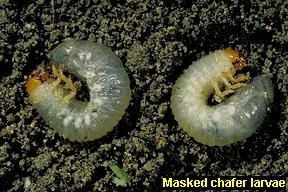Advice for the Home Gardener From the Help Desk of the
UC Master Gardener Program of Contra Costa County
Client's Request: I need some help in ridding my raised vegetable beds of white grubs. This is a school garden and I haven't had this problem before. I have been researching the various types of control from Diatomaceous Earth to White Milky Spore, etc., and I haven't come up with a solution but having the children of our school dig for them. I would like to eradicate them as soon as possible as I need to get my vegetable transplants into the raised beds. I look forward to getting your advice.
MGCC Help Desk Response: Thank you for contacting the UC Master Gardener Program Help Desk with your questions about removing white grubs from your school's raised vegetable beds.
The grubs you are seeing are most likely the larval stage of masked chafer beetles. The ¾ inch adult beetles are golden brown in color, with dark brown heads and hairy undersides. The grubs are whitish in color, with brown heads and legs, dark stripes on their backs, and bristles on the undersides of their posterior abdomens. The fully grown grubs are about an inch in length, and are c-shaped.
Here is a picture of these masked chafer grubs:

The grubs are root feeders, and are typically found in lawns, although they are found in vegetable beds as well.
This UC publication provides some information on masked chafer grubs: http://ipm.ucanr.edu/TOOLS/TURF/PESTS/inchaf.html
Physical removal of the grubs from the beds is the first line of defense. Your students' hand-picking is a great approach. You can also get help from birds and other predators by turning over the soil to expose the grubs.
Beneficial nematodes can also be used for biological control of grubs, as described in the article at the following link: http://ipm.ucanr.edu/TOOLS/TURF/PESTS/innem.html.
The challenge, though, is that the timing for beneficial nematodes is not optimum. Beneficial nematodes are most effective against white grubs in the summer and early fall and requires soil temperatures above 60 degrees. This may be something to consider as you wrap up your vegetable garden in the late summer.
In terms of the products that you were considering, there are no indications from the University of California that the products are effective. Milky White Spore is most effective against Japanese Beetle larvae, which are essentially not present in California. The beneficial nematodes are the recommended alternative.
There is also no UC information indicating that diatomaceous earth is effective. One concern about diatomaceous earth is that it could kill ls beneficial insects, so you may not want to put it in your vegetable bed.
There are some chemicals, such as imidacloprid, that can be used, but this is primarily in lawns, and timing has to be exact. I would not want to recommend it for a vegetable garden.
Hand-picking is the best approach. While the grubs can damage vegetables, if your students can keep the grub population under control through hand-picking, your vegetables may do fine.
One additional note of caution: Be careful when it comes to amending the soil in your beds with fresh compost (e.g., made on-site). That compost could contain masked chafer eggs. The larvae (grubs) will locate and feed on roots after they hatch. Before applying compost, be sure it has been properly prepared with sufficient heat to decompose the organic material and to kill insect eggs and other organisms.
Good luck with your vegetable garden. Let us know if you have further questions.
Help Desk of the UC Master Gardener Program of Contra Costa County (ECS)
|
|
